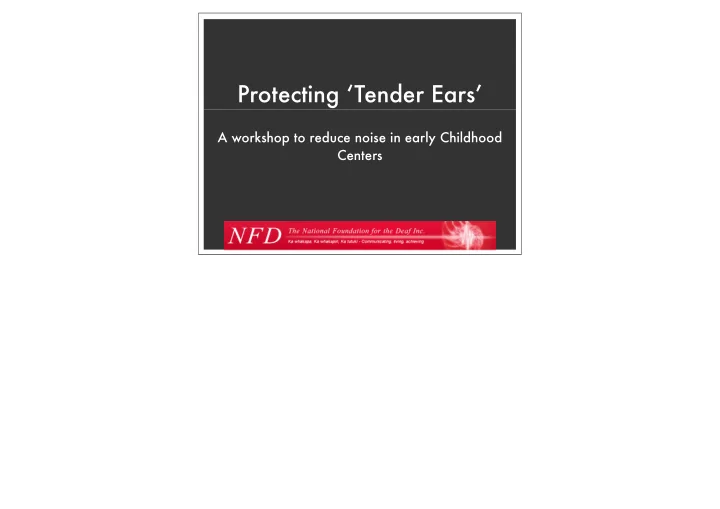

Protecting ‘Tender Ears’ A workshop to reduce noise in early Childhood Centers
Why are we here? • Protect the tender ears of children • Protect the tender ears of Early Childhood Educators
The problem • Deaf Awareness Week survey 2009 • 20% of children affected by high levels of noise • McLaren 2009 • 75% of Children & 50% of staff exposed to excessive noise • Educators losing their hearing • Classroom acoustics
The problem • Legislation change pending. Noise as an OHS harm issue • Lower noise = Effective pedagogy (Min of Ed BES) Affects learning and living
It’s the end of the day, how do you feel?
Where does noise come from?
When does noise peak?
What is NFD doing? Who is NFD? A NGO charitable organisation - Supports NZers with hearing loss - Encourage hearing preservation - Promotes good sound
๏ NIHL Strategy ๏ Gap/Needs analysis ๏ Early childhood sector ๏ Forum ๏ Early Childhood Council ๏ Noise meter + resources ๏ National workshop series
Plug and Play solutions Traffic Light noise meter
Noise • Room acoustics • Duration and intensity
Plug and Play solutions Autex DIY ‘Peel & Stick’ ($100/6) Wallcovering ($65 - 70 installed)
What works for you? • What strategies, resources, activities do you use?
Chill...... • Music • Yoga • Quiet zones • Meditation
Where noise comes from in centers • From the workshops with Educators, here’s where they say the biggest sources of noise are... • Musical instruments, music, dishwasher, the block corner, transition times, pick up and drop off times, running, running round screaming, tantrums, traffic, furniture being moved, stereo, crying children • All of these add up to produce a ‘cafe effect’ - the noise level rises, so people get louder to be heard, so the noise level rises, so people get louder to be heard etc
What we can do about it • From the workshops with Educators, here’s where they say we can reduce noise... • Use acoustic control materials - sound proofing coverings • Use noise meter to educate • Lower noise, calm children, before transition times to reduce ‘cafe effect’ • Set up quiet zones in the center using mats, partitions and combining quiet activities in an area of the center • Break up noisy activities into smaller areas. Buffer with partitions or furniture • Use visual cues to get attention or give directions e.g coloured flags for transitions
What we can do about it • Organised transitions, clear and precise directions, • Meaningful tasks so children are engaged, occupied and challenged. Teacher engaged and involved • Staff role modelling being/using quiet • Professional development on Noise so there is a team approach. • Do a ‘noise audit’. Take the ‘sharp edges’ off i.e the things that make noise like scraping chairs, putting foam seal on door jabs to soften the noise of closing doors etc • Use rolling morning teas • Be flexible
Recommend
More recommend